#Dr Zahi Hawass
Explore tagged Tumblr posts
Text
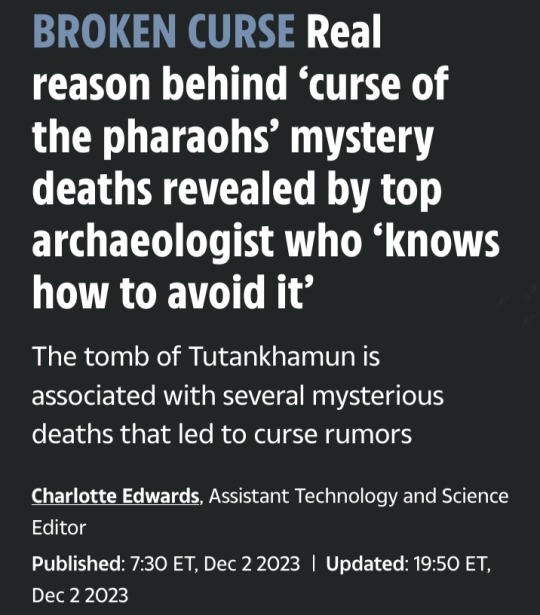
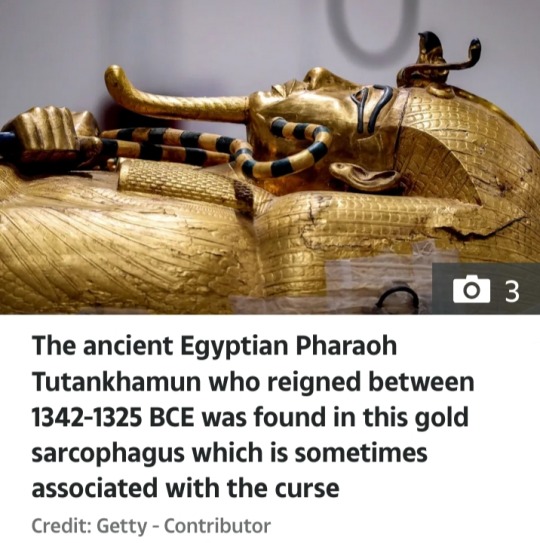
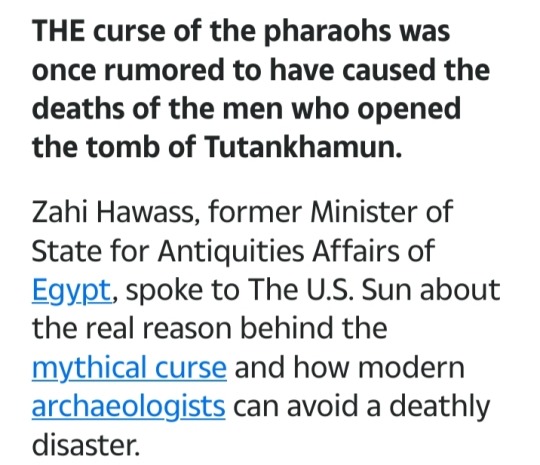
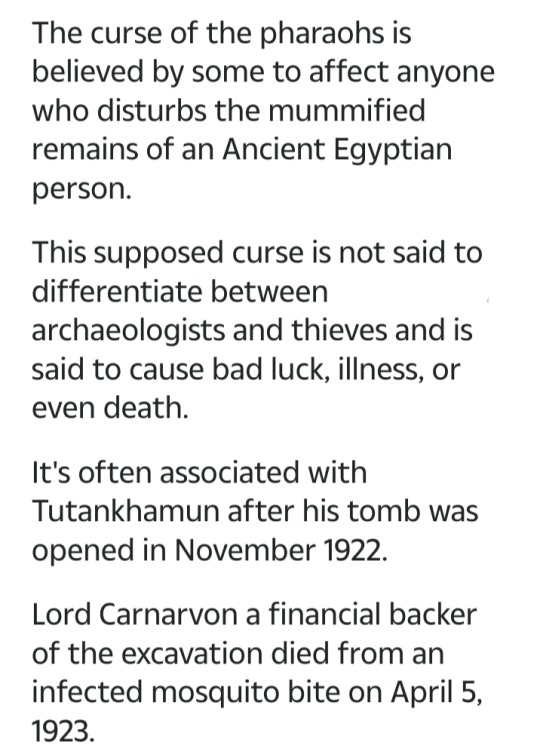
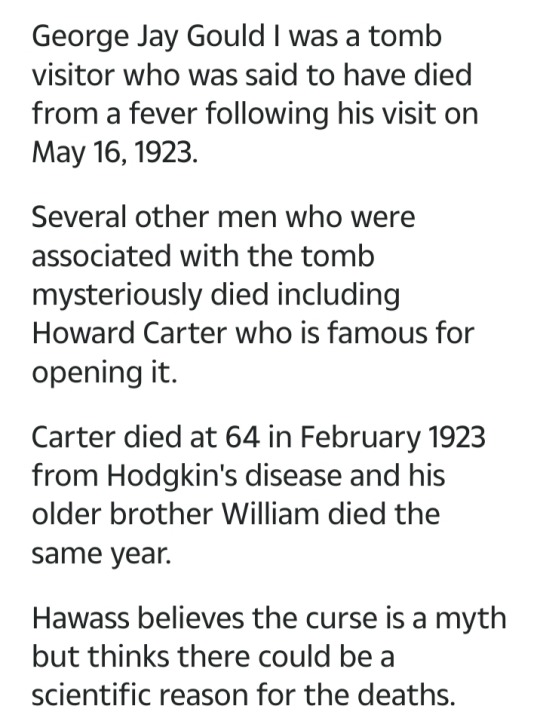
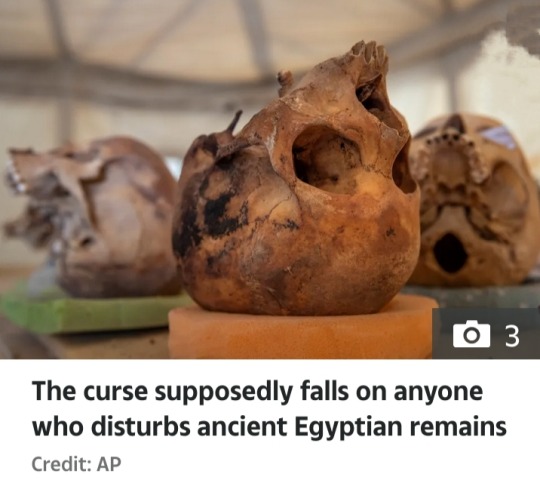
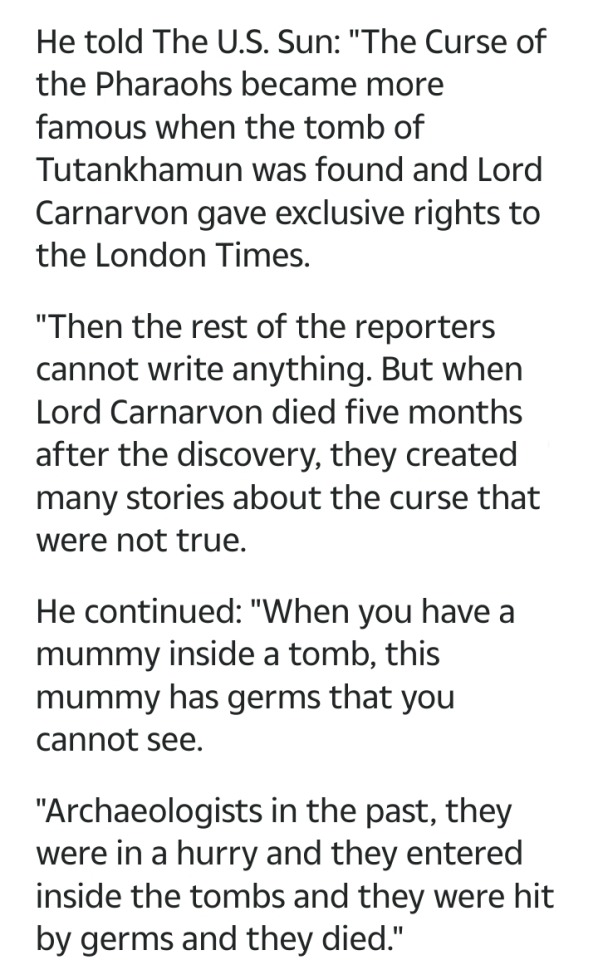
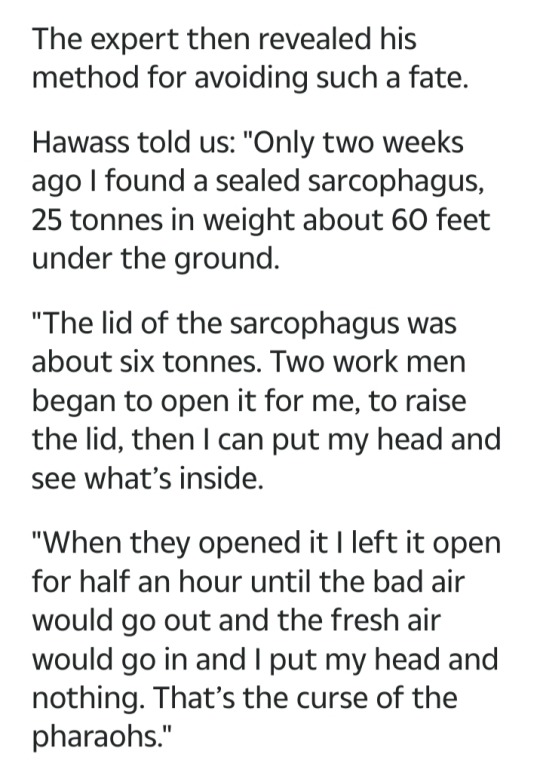

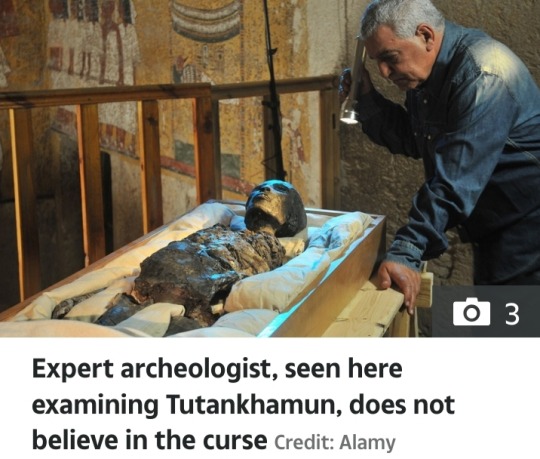
#Tutankhamun#Tomb of Tutankhamun#curse of the pharaohs#Ancient Egypt#Ancient Civilization#Dr Zahi Hawass#Minister of State for Antiquities Affairs#Egypt#mythical curse#archaeology#sarcophagus#mummified remains#Lord Carnarvon#Howard Carter#George Jay Gould I#mummies#germs#curse#Ancient Egyptian Pharaoh
62 notes
·
View notes
Link
Dr. Zahi Hawass, a former Egyptian Antiquities minister who styles himself as a real-life Indiana Jones, is about to embark on a 23-city lecture tour in the US, speaking at convention centers in all major US cities. No one seems very concerned that he is a Jew-hater. He has said that Jews immigrated to America, took over its entire economy, and now control the entire world. Hawass wrote in 2009, "The concept of killing women, children, and elderly people.... seems to run in the blood of the Jews of Palestine" and that "the only thing that the Jews have learned from history is methods of tyranny and torment—so much so that they have become artists in this field." "When I speak of the Jewish faith, I do not mean their [original] faith, but the faith that they forged and contaminated with their poison, which is aimed against all of mankind," he added. This distinguished academic also claims that the Tomb of the Patriarchs in Hebron, and Rachel's Tomb in Bethlehem, have nothing to do with Judaism. Hawass has repeatedly rejected the idea of a museum of Egyptian Jewish history, similar to a museum of Coptic history in Egypt, saying, "How can we have a Jewish museum for the occupiers of Palestine?"\ If an avowed racist was to lecture in the US on any topic, there would be an uproar. But a Jew-hater, who happily spreads the most vile conspiracy theories about Jews? Not a word of protest. What would it take to get Jews to protest this lecture series?
20 notes
·
View notes
Text
Return looted antiquities. Sign Dr Hawass's petition:
#antiquities#dr hawass#egyptology#museums#nazi looted treasures#berlin#germany#nefertiti#zahi hawass#tourism#looted#treasure#history#egyptian pharaoh#art#cairo#pyramids#queen#archeology#national treasure#egyptian history#egyptian
4 notes
·
View notes
Text
Speaking both as someone who is Armenian (i.e. Caucasian but with enough “non-white” features that people try to guess my ethnicity and are often wrong) and an Egyptologist...Cleo WASN’T black. She was mixed at best, but her family was part of Lexie the Greatly Exaggerated’s conquering forces, so she was Greek/Macedonian. Even coins minted at the time show her with Greek-styled hair and features. Having someone like Anya Taylor-Joy depict her would also be inaccurate because, even if her origins are European, she would have had dark (but not black) skin, a large nose, and since the “sexy seductress” thing was largely Roman propaganda, it’s entirely possible she wasn’t even conventionally attractive.
In terms of “Egypt is on the African continent therefore it’s an African country and therefore its people were black”...also no. Egyptian art makes a distinction between Egyptians and people from further south in Nubia, Kush, and Punt. The Egyptians’ ancestors were more likely similar to the Bedouin, as in desert nomads who were brown but not black. The earliest confirmed permanent settlements in Egypt and the artifacts found there show similarities to artifacts from the Levant, to the northeast, but dated later than the Levant’s which means the earliest Egyptians (or at least the people who traded with them) were from the Arabian Peninsula. (Source: A History of Ancient Egypt: From the First Farmers to the Great Pyramid by John Romer) Depicting Cleopatra as very dark-skinned IS blackwashing, and I can understand the Egyptian government balking at diasporic African Americans trying to lay claim to a culture that isn’t theirs simply because it’s on the same continent as their ancestors. (That being said, I have never set foot in Armenia, don’t speak any Armenian, and I’m not even Christian, but I still have strong feelings about which country should have claim to Mount Ararat, so I get that too.)
Do I think it’s funny that Netflix is getting sued over something like this? Yes. Do I want the Egyptian government to win? Sort of, in that it would set a precedent for others who might want to shut down production of a program that is offensive to their culture. The issue is the line between “This is actually offensive and harmful to this ethnic group” and “This isn’t how I imagine these fictional/historical figures to look and I’m upset I wasn’t consulted” and how bad people are at knowing which side of that line they’re on. I’ll be interested to see how this turns out.
An Egyptian lawyer has filed a case with the Public Prosecutor to close the Netflix platform after the trailer of “Queen Cleopatra" was released, which depicts the Greek historical figure as a black-skinned woman.
According to Egypt Independent, Mahmoud al-Semary demanded that all legal measures be taken against those responsible for the documentary and the management of the streaming platform for its participation in “this crime.” He also called for an investigation and for Netflix to be blocked in Egypt.
The case said that the documentary promotes Afrocentrism that is widely spread on social media, which have slogans and writings aimed at distorting and obliterating the Egyptian identity.
The complaint continued addressing Public Prosecution: "In order to preserve the Egyptian national and cultural identity among Egyptians all over the world and take pride in it, and to consolidate the spirit of belonging to the homeland, and accordingly we ask and seek you to take the necessary legal measures against this platform."
It demanded stopping broadcasts showing all works aimed at obliterating and distorting the Egyptian identity, through films aimed at falsifying and distorting history in Egypt.
The complaint accused makers of the documentary and platform management of forgery.
A Netflix docudrama series that depicts Queen Cleopatra VII as a black African has sparked controversy in Egypt. A lawyer has filed a complaint that accuses African Queens: Queen Cleopatra of violating media laws and aiming to "erase the Egyptian identity". A top archaeologist insisted Cleopatra was "light-skinned, not black". But the producer said "her heritage is highly debated" and the actress playing her told critics: "If you don't like the casting, don't watch the show." Jada Pinkett Smith, the American actress who was executive producer and narrator, was meanwhile quoted as saying: "We don't often get to see or hear stories about black queens, and that was really important for me, as well as for my daughter, and just for my community to be able to know those stories because there are tons of them!" But when the trailer was released last week many Egyptians condemned the depiction of Cleopatra. (x)
#egyptology#Ancient Egypt#people were protesting outside a lecture I attended by Dr. Zahi Hawass for not depicting King Tut as black enough#again I get it but there ARE plenty of black ancient historical figures you can choose from#ones that few people know about and need more press in the first place#and if you want to go claiming Egyptian queens might I suggest Nefertiti?#there's a chance she might have been black or at least darker skinned#Cleopatra was Mediterranean and you can't change that
468 notes
·
View notes
Text
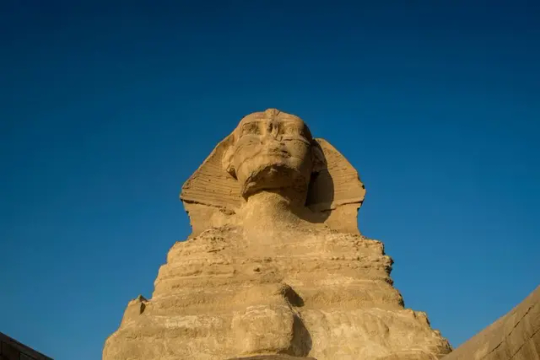
The Hunt: What Happened to the Great Sphinx’s Nose?
The mystery of the Egyptian statue's missing nose has fascinated people for centuries.
Much like the desert winds that perhaps helped shape it, conspiracy theories swirl around the Great Sphinx guarding the Giza plateau—especially regarding how the winged lion’s human head lost its nose. One enduring hypothesis blames Napoleon Bonaparte’s troops for blowing the snout off during target practice. While that conspiracy’s long-debunked, it persists in popular culture. Director Ridley Scott knowingly depicted the myth in last year’s Napoleon biopic, without sacrificing any of his film’s critical acclaim. However, Egypt’s Dr. Zahi Hawass told Britannica, “We have, really, to say to everyone that Napoleon Bonaparte has nothing to do with destroying the Sphinx’s nose.”

Napoleon’s 1798 battle didn’t even take place on the Giza plateau, but 10 miles north at Imbabah. Some theories have posited that storms and earthquakes shook the Sphinx’s nose from its face. Others squabble over which regional conflict (if not Napoleon’s Battle of the Pyramids) led to the nose’s destruction. In 1990, J.P. Lepre noted that “the figure was used as a target for the guns of the Mamluks,” who were actually Napoleon’s opponents.
The French emperor did, however, lay eyes on the Sphinx’s face when he arrived in Giza, with many soldiers, painters, and engravers in tow. “Thousands of years of history are looking down upon us,” he reportedly exclaimed beneath the monument’s gaze. Napoleon didn’t respect borders, but he did respect history. The Waterloo Association called the lingering accusations against him “particularly unjust because the French general brought with him a large group of ‘savants’ to conduct the first scientific study of Egypt and its antiquities.” The resulting Orientalist survey ignited an Egyptian fervor back in Europe.
Primary materials prove the nose removal predated Napoleon, too. Danish naval captain Frederic Louis Norden’s sketch from 1738 depicts the Sphinx without its central facial feature. What’s more, French naturalist Dr. Pierre Belon visited the Sphinx in 1546, writing that it had sustained damage and “no longer [had] the stamp of grace and beauty so admired by Abdel Latif in 1200”.
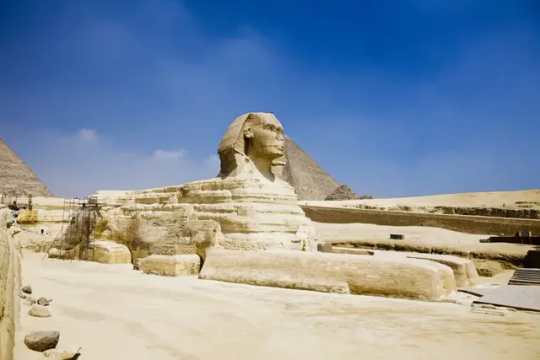
Medieval Arab scholars such as al-Maqrīzī pin the damage on Muhammed Sa’im al-Dahr, a 12th-century Sufi Muslim from a respected Cairo convent, who was allegedly angry that peasants used the Sphinx to entreat Abul Hol (the Arabic name for the sphinx) into helping their harvests. Removing an idol’s nose was an accepted method to suffocate spirits inside. Still, the details remain up for debate. Hawass believes that al-Dahr acted alone. Others claim he hired men to desecrate the Sphinx. Most experts, however, agree the great statue’s nose came off with a chisel. It is also generally accepted that al-Darhr’s actions got him killed by angry villagers. Sadly, the nose itself has likely crumbled into the desert.
By Vittoria Benzine.
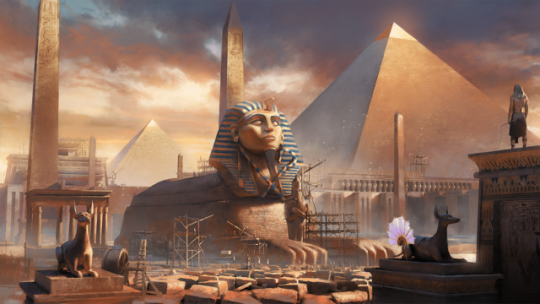
#the sphinx#The Hunt: What Happened to the Great Sphinx’s Nose?#Giza Plateau#sculpture#statue#pharaoh Khafre#ancient artifacts#archeology#archeolgst#history#history news#ancient history#ancient culture#ancient civilizations#ancient egypt#egyptian history#egyptian gods#egyptian pharaoh#egyptian mythology#egyptian art#ancient art
16 notes
·
View notes
Text
Dr. Zahi Hawass, the renowned Egyptian archaeologist, delivered a lecture at the University of Copenhagen in Denmark about recent archaeological discoveries.
4 notes
·
View notes
Text
Cairo Top Tours
Sie sollten mit Ihren Freunden und Ihrer Familie nach Ägypten kommen, um eine besondere Zeit in diesem wunderbaren Land zu verbringen.
@cairo-top-tours
#Egypt#Tourism#Tours#Cairo#Come_to_Egypt#Excursions#cairo day tours#cairo top tours#egypt tours#cairo tours
4 notes
·
View notes
Text
zahi Hawas se esfuerza por recuperar las antigüedades egipcias
#Travel#tourism#Cairo#Egypt#Pyramids#come_to_Egypt#Tour#Vacation#trip#day tour#cruise#Nile#Luxor#Aswan#Cairo_top_tours
6 notes
·
View notes
Text
O Dr. Zahi Hawass está fazendo viagens especiais para ajudar mais pessoas a visitar e aprender sobre as coisas legais do Egito.
O Dr. Zahi Hawass está fazendo viagens especiais para ajudar mais pessoas a visitar e aprender sobre as coisas legais do Egito. @cairo-top-tours
3 notes
·
View notes
Text
Esses passeios oferecem a chance de explorar atrações e pontos de referência próximos, como a Cidadela de Qaitbay, o Canal de Suez ou o Mar Vermelho..... https://medium.com/@zahwaabdelhamid21/o-dr-zahi-hawass-renomado-arque%C3%B3logo-eg%C3%ADpcio-deu-uma-palestra-na-universidade-de-copenhague-na-3f1df28a9444 @CairoTopTours
2 notes
·
View notes
Text

Aguas con el mercurio rojo,
Durante siglos han persistido los rumores sobre una sustancia poderosa y misteriosa. Y en estos días, los anuncios y videos que lo ofrecen a la venta se pueden encontrar en línea. ¿Por qué ha perdurado la historia del "mercurio rojo"?
Hay quienes creen que es un elixir curativo mágico que se encuentra enterrado en la boca de las momias egipcias antiguas.
¿O será un material nuclear poderoso que podría disparar el apocalipsis como algunos aseguran?
Sin embargo, hay un pequeño problema con todas esas aseveraciones: el mercurio rojo no existe. A pesar de ello, puedes encontrarlo en las redes sociales y en numerosos sitios web. Cantidades pequeñas de la mítica sustancia a veces se ofrecen a un precio de miles de dólares.
Muchos de los anuncios muestran una foto borrosa de un glóbulo de líquido rojo en un plato. Junto a él, a menudo hay un número de teléfono garabateado en una hoja de papel, por si alguien lo suficientemente ingenuo quiere contactar al vendedor.
"Solo compradores serios", se lee en un anuncio. "Necesitamos pruebas de fondos para dar pruebas del producto".
La impresión dada es que se ofrece una mercancía misteriosa e ilícita. "Es una estafa y el riesgo es que engañen o le roben a la gente", dice Lisa Wynn, jefa del departamento de antropología de la Universidad Macquarie en Sídney, Australia.
En pos del mercurio rojo Wynn oyó hablar del fenómeno por primera vez cuando trabajaba en las pirámides de Giza en Egipto y compartía una oficina con el destacado egiptólogo Dr. Zahi Hawass.
Un día, el Hawass recibió la visita de un príncipe saudita cuya madre estaba en coma. "Este hombre había gastado todas sus energías y dinero tratando de encontrar algo que salvara a su madre", recuerda la antropóloga. "Finalmente había recurrido a un jeque en Arabia Saudita, un curandero, quien le había dicho que había una sustancia mágica enterrada en las gargantas de las momias en el antiguo Egipto. Le indicó que si iba a Egipto y hablaba con ese arqueólogo, él podría proporcionarle mercurio rojo".
Pero eso no fue lo que ocurrió. "Hawass le dijo: 'Siento mucho lo de tu madre, pero eso es una tontería: no existe el mercurio rojo'". Tras presenciar la escena, la asombrada Wynn descubrió que esa no era una experiencia nueva para Hawass y sus colegas. Se enteró de que a menudo conocían árabes que creían que el mercurio rojo era una cura mágica que había sido enterrada con los faraones. Los orígenes de esta creencia son confusos. Se pueden encontrar indicios en el trabajo del alquimista y filósofo medieval Jabir ibn Hayyan, quien escribió: "Los elixires más preciosos que jamás se hayan mezclado en la Tierra estaban ocultos en las pirámides".
Una historia de vampiros En tiempos más recientes, algunos de los que buscan mercurio rojo han llegado a creer que también se puede encontrar en los nidos de murciélagos. El inconveniente es que los murciélagos en realidad no hacen nidos, pero eso no ha impedido que los cazadores de fortuna perturben sus hábitats para buscar el mítico elemento escarlata. Algunos han llevado la teoría de los murciélagos un paso más allá y afirman que el mercurio rojo proviene de los murciélagos vampiros. Dentro de esa lógica, la sustancia exhibe las mismas propiedades que los vampiros de películas de terror. Por lo general, una gota roja, que a menudo parece sospechosamente creada con gráficos de video, se ve repelida por el ajo y atraída por el oro. Cuando está frente a un espejo, la gota aparentemente no tiene reflejo. Las cualidades supuestamente sorprendentes del mercurio rojo no terminan ahí. Se alega que tiene poderes para convocar seres sobrenaturales. En 2009, se difundió una historia en Arabia Saudita de que el mercurio rojo se podía obtener sin entrar en una tumba antigua o tamizar el guano de murciélago. Se rumoreaba que se encontraron pequeñas cantidades de la preciada sustancia dentro de las máquinas de coser Singer antiguas. La policía comenzó a investigar el engaño después de que esos objetos domésticos tan comunes comenzaron a cambiar de manos por decenas de miles de dólares. Pánico por mercurio rojo En algunos momentos de la historia, los rumores sobre la sustancia se han multiplicado a causa de la geopolítica global. A fines de la década de 1980, cuando los gobiernos comunistas colapsaron en Europa del Este, hubo incertidumbre sobre lo que estaba sucediendo con sus existencias de material nuclear. En ese momento, Mark Hibbs era un periodista que investigaba rumores alarmantes de que extraños individuos ofrecían a la venta un material nuclear previamente desconocido, creado en laboratorios soviéticos. En ese caso, la versión de la historia del mercurio rojo era diferente de la del elixir curativo enterrado con los faraones. Se decía que el mercurio rojo soviético era destructivo, capaz de causar una tremenda explosión nuclear con cantidades no mayores que una pelota de béisbol. El escenario de pesadilla era que esta sustancia llegara al mercado negro de armas y terminara en manos de grupos violentos o estados corruptos. Sin embargo, Mark Hibbs dice que cuando los gobiernos occidentales investigaron, concluyeron que el mentado material con el potencial para acabar con el mundo no existía. Facebook y Twitter dijeron que habían asumido una postura dura contra la actividad fraudulenta, y eliminado los anuncios rojos de mercurio que les señalamos. Cabe aclarar antes de finalizar que sí existe un mineral de color rojo que contiene mercurio: el sulfuro de mercurio. Pero comparado al mitológico mercurio rojo, es una sustancia mundana.
Aunque es muy útil para decorar cerámica, no cura nada; de hecho, puede llegar a ser perjudicial para la salud, no porque sea altamente explosivo, sino porque el mercurio -ese que ese plateado- de por sí lo es.
2 notes
·
View notes
Text


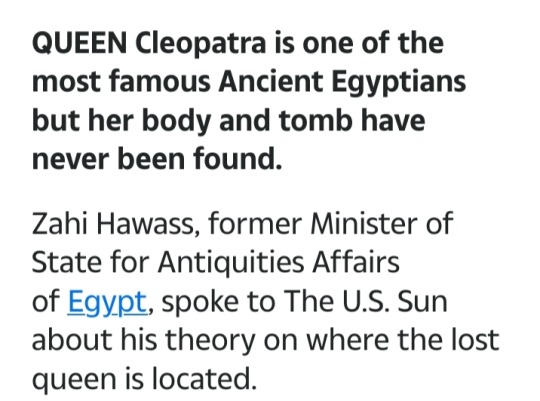

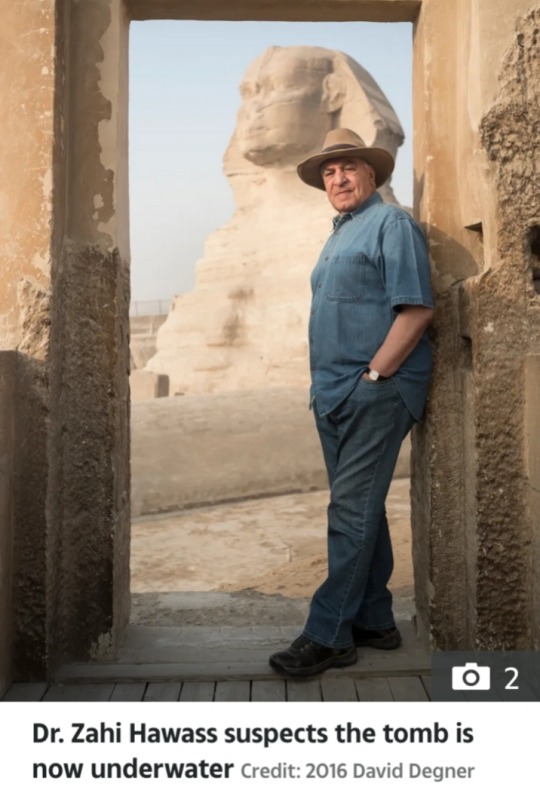




#Queen Cleopatra#Cleopatra#Ancient Egypt#Cleopatra's Tomb#Taposiris Magna#Dr Zahi Hawass#Antiquities Affairs of Egypt#Dr Kathleen Martínez#Mark Antony#Octavian#Augustus#Alexandria#egyptology#archaeology#lost tomb#tomb#Ancient Civilization
9 notes
·
View notes
Text
Dr. Zahi Hawass with the artist Rob Law to Explain The Mysteries of the Great Sphinx and Khufu Passage @cairo-top-tours
2 notes
·
View notes
Photo




Through the Years → Queen Mathilde of Belgium (1,369/∞)
15 March 2023 | Working Visit of Queen Mathilde and Princess Elisabeth to the Arab Republic of Egypt (Day 2) 1) Photo Opp at Winter Palace 2) Visit to the archaeological site of El Kab 3) Visit to the archaeological site of Shaykh Abd-al-Qurna (visit of Tomb Sennefer & Tomb Amenhotep) 4) Visit to the Tomb of Tutankhamon with Dr. Zahi Hawass (Valley of the Kings) 5) Visit of Golden City with Dr. Zahi Hawass in Luxor, Egypt. (Photo by Didier Lebrun / Photonews via Getty Images)
2 notes
·
View notes
Text
Riesige archäologische Entdeckungen

Entdeckungen in Ägypten: Das Tourismusministerium gab mehrere Entdeckungen in verschiedenen Gebieten bekannt.Unter der Leitung von Dr. Zahi Hawass fanden die ägyptische Archäologiemission und einige ausländische Missionen statt.
Den Anfang machte Luxor, insbesondere der Totentempel der Hatschepsut, da dieser als erste archäologische Entdeckung dieses Jahres gilt. Dort entdeckten sie vollständige Ablagerungen dieser Königin und auch viele Blöcke für sie und König Thutmosis III., dessen Farben gleich geblieben waren, zusätzlich zu einem Grab mit der Inschrift „gehoti-Mes“, was so viel bedeutet wie „der Große Geborene“. Er war der Aufseher des Palastes von Königin Teti Sheri in der 8. Dynastie des Alten Königreichs. Sie war die Mutter von König Seqenenre, der im Befreiungskrieg gegen die Hyksos starb, die von seinem Sohn, König Ahmose, aus Ägypten vertrieben wurden. Sie entdeckten viele Artefakte, beispielsweise Töpferwaren, Kriegsbögen und viele andere Dinge. Und was die weitere Entdeckung betrifft, die in der Gegend von Sakkara stattfand, so wurden vier Gräber aus der zweiten und dritten Dynastie sowie einige Bestattungen aus der achtzehnten Dynastie im neuen Reich entdeckt. Es wurden mehrere archäologische Stücke und Fragmente von Holz- und Keramiksärgen gefunden. Eine weitere große Entdeckung wurde in der Gegend von Sakkara gemacht. Es handelt sich um die Entdeckung einer Mastaba namens Teti Neb Fu, eines ägyptischen Privatarztes von König Pepi II. aus dem Alten Reich. Sie stellten fest, dass zu verschiedenen Zeiten mehrere Dinge daraus gestohlen worden waren, und sie fanden auch einen Steinsarg, in den der Name des Grabbesitzers eingraviert war. Jeder möchte nach Ägypten kommen, um diese Entdeckungen zu sehen und einige Ausflüge zu machen.Ägypten-Touren sind eine tolle Idee, um Ägypten zu sehen und besser kennenzulernen.
Ich denke, dass es in Ägypten viele wundervolle Touristenorte gibt, sei es in der Hauptstadt, in Oberägypten oder auch in den Gebieten in Meeresnähe.
Wir kennen alle diese Orte durch den Ägypten-Reiseführer, der Ihr bester Führer ist, um viele wundervolle Orte in Ägypten zu entdecken und die großen Entdeckungen Ägyptens zu erleben.
0 notes
Text
Zahi Hawass anuncia varios descubrimientos arqueológicos sobre el templo de la reina Hatshepsut…
El arqueólogo egipcio Dr. Zahi Hawass, jefe de la misión arqueológica conjunta de la Fundación Zahi Hawass para las antigüedades y el patrimonio, en cooperación con el Consejo Supremo de Antigüedades y el Ministerio de Turismo y Antigüedades, anunció varios descubrimientos arqueológicos. Luxor es una de las ciudades muy importantes en Egipto; no es posible visitar Egipto sin explorarla , por lo tanto nuestras excursiones por Egipto le brindan esa oportunidad maravillosa.
Hawass dijo que, durante tres años de investigación y excavaciones científicas que comenzaron en septiembre de 2022, la misión logró hacer una serie de importantes descubrimientos arqueológicos en la zona situada al comienzo de la carretera ascendente hacia el templo de la reina Hatshepsut en Deir el-Bahri, Puede visitarle a través del guía de viajes de Egipto que se considera su guía principal durante sus excursiones.
La misión descubrió parte de los cimientos del Valle de los Reyes, situado en las afueras del valle y puerta principal de entrada al templo funerario de la reina Hatshepsut, llamado «Jisro Jisro», que es uno de los templos faraónicos más bellos de la historia.
Hawass señaló que la misión encontró un gran número de inscripciones del Templo del Valle, que se consideran uno de los ejemplos más raros y bellos del arte de la escultura en la época de la reina Hatshepsut y Tutmosis III, que no tienen análogos en los museos egipcios, salvo unos pocos ejemplos en los Museos de Luxor y Metropolitano, y las inscripciones reales recién descubiertas son la colección más completa jamás descubierta de los restos del Templo del Valle, que fue demolido durante la época de Raamessa y la Dinastía XIX. Las atracciones de El Cairo son su recorrido genial para descubrir la capital de Egipto. Es tan importante explorar la zona de las Pirámides de Giza, que es un testigo de la civilización increíble de los antiguos, además del Cairo copto e islámico, que le dan una visión completa de la vida de los antiguos egipcios. Y una vez que visite El Cairo, está obligado a visitar el bazar de Khan el Khalili, un mercado lleno de memorias inolvidables.
El Dr. Mohamed Ismail Khaled, Secretario General del Consejo Supremo de Antigüedades, declaró que la misión encontró más de un centenar de placas de piedra caliza y arenisca con los nombres y cartelas de la reina Hatshepsut (nombre de nacimiento y nombre de coronación) y que forman parte de los depósitos de cimentación que confirman la propiedad del dueño del templo, conocido como el Nombre de Piedra.
Entre estas placas de piedra se encuentra una placa única de piedra caliza que lleva en relieve el nombre y el título del arquitecto de la reina Hatshepsut, el ingeniero «Senmut» y su título de supervisor del palacio.El conjunto completo de depósitos de cimientos de la reina Hatshepsut es uno de los descubrimientos más importantes de la misión, que se produce casi un siglo después de que el científico estadounidense Herbert Wenlock revelara el último conjunto completo de depósitos de cimientos de la reina Hatshepsut en el emplazamiento del templo mortuorio (1923-1931).
Hawass destacó que la misión encontró varias tumbas rupestres del Reino Medio (2050-1710 a.C.) y reveló la cronología del yacimiento, que comenzó a ocuparse en el Reino Medio y continuó hasta principios de la Dinastía XVIII, cuando el ingeniero real Senmut ordenó detener los enterramientos en la zona y la eligió como emplazamiento para la construcción del Templo del Valle y parte de la ampliación de la calzada ascendente que conectaba el Templo del Valle y el templo funerario. Senmut enterró la tumba bajo grandes cantidades de arena como parte de la preparación del lugar para la construcción del Templo del Valle.

0 notes